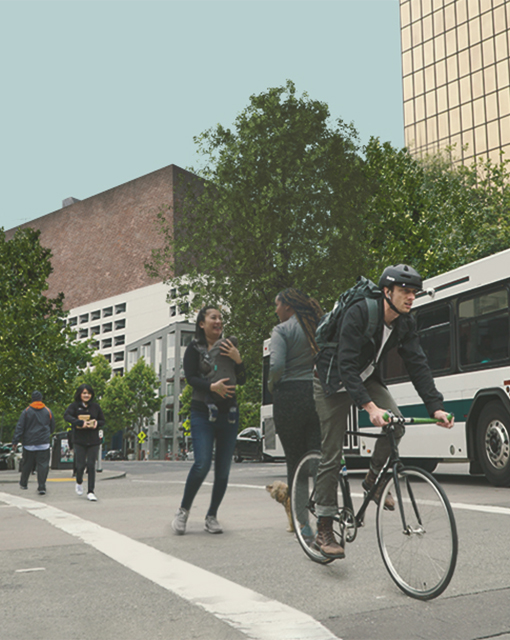Active Modes and Complete Street Design During COVID-19
Partner with Us to Pivot Our Research
As communities and individuals adapt to the COVID-19 circumstances and uncertainty, changes are emerging in all aspects of travel behavior. Unraveling what these changes mean for walking, biking, and complete street design is essential for addressing safety and strategy. With this background in mind, we have been starting conversations and listening to some of the key questions being asked by our clients and partners across the country during the COVID-19 response. We are now taking action to accelerate new practices and innovations that were already in our 2020 Research & Development (R&D) agenda. Additionally, we are moving to identify the best ways to help agencies plan for and respond to this uncertain future, but also with an eye toward advancing our industry’s best practices into the future.
What We’re Hearing
- Essential Worker Travel – How do we ensure streets are still utilitarian, particularly for essential workers?
- Increases in Recreation Trips – What are the effects of and considerations for the increases in walking and biking trips on streets, and will this trend endure?
- Speed and Collision Effects – While collisions are down, speed is up now that auto volumes have substantially decreased. As a result, fatal and severe injury collisions have not declined (see UC Berkeley’s SafeTrec compiled week-by-week California statistics for more information). With more people walking and biking, how do we address these major safety implications for the most vulnerable street users?
- New Strategies – In what ways are cities around the world adapting? How are they accelerating efforts to make streets safer for walking and biking?
- Innovative Strategy Implementation – How are cities able to employ these new strategies? Many of the cities with innovative pilot projects or quick responses to improvements in walking and biking are able to move them forward with support and political will from the highest levels of municipal government – how does this happen for more cities?
- Engineering and Planning Tools – What types of tools and approaches can help improve public health and safety efficiently? Some cities have relied on existing plans to guide implementation, while other cities are taking an opportunistic approach based on newly emerging demand patterns. For example, cities are using pedestrian recall as a vector management strategy (with no need to push buttons), and shorter signal cycles to address speeding and reduce wait times for pedestrians crossing major streets. What other approaches are possible and feasible?
- Transportation Revolution – Do pandemic pilots and other temporary uses constitute a “transportation revolution?” What modifications may become permanent? Regardless of the fate of any individual projects, what important questions are being raised about the appropriate management of the public right-of-way, and what elements of adaptability are being injected into our transportation networks?
- Partial Opening – What will a partial opening look like? How do we work to manage social distancing while walking and biking is critical? Will cities look to one-way circulation on paths, or to widening sidewalks or bike lanes temporarily to move people at safe distances? How can we make streets more equitable going forward?
- Funding Shortfalls – Will discretionary funding take a major hit in the upcoming months, and potentially beyond? How will we prioritize impactful and cost–effective projects for stimulus funds? What other funding remains?

How We’re Responding
We are accelerating actions that were already on our R&D action plan and adapting them to the current situation:
- Helping cities plan and engineer shovel–ready projects – We know from the last recession that shovel–ready projects helped cities secure competitive grant funding and start their communities working and moving. We are helping cities to prioritize their efforts and prepare engineering drawings and grant applications to get projects ready for funding.
- Developing systemic analysis tools and design strategies for projects large and small – Our work on Systemic Intersection Analysis tools will help cities quickly identify multimodal intersection improvements at the corridor, district, or citywide scale. This enables them to be ready for grant opportunities with various criteria and funding levels. Additionally, our cost-effective Quick-Build designs allow cities to deliver benefits promptly and demonstrate readiness for the future implementation of more costly elements.
- Homelessness and Safety – We are developing a research needs statement on the active transportation and safety needs of the most vulnerable populations in our communities.
- Quick Build Programs – As truly quick and lower-cost responses, we are developing quick-build strategies to get safe, comfortable bikeways and pedestrian improvements on the ground.
What We’re Seeking
We’re here to help. What are your biggest hurdles right now around active transportation and complete streets? How can we collaborate to develop effective solutions? Our investments in innovation are most useful when they address shared difficulties and obstacles across diverse regions and communities. Contact our leaders in this topic – Carrie Modi, Matt Benjamin, or Ryan McClain – today to discuss your challenges, needs, and ideas with us. Together, we can meet this unique moment with the resolve that is needed to emerge stronger.
How is the pandemic changing things and how can we further shift our R&D efforts in response?
Here’s what we’re hearing from clients and partners in the areas of:

